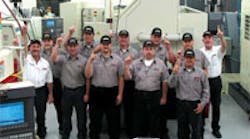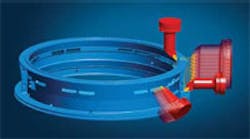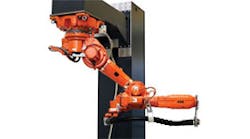The shop team at Richard Childress Racing
Richard Childress formed a potent alliance with Dale Earnhardt in the early 1980’s, and launched what is now a 400-person racing empire that is well-known to NASCAR’s 75 million fans.
Childress, a former NASCAR driver himself who today is president and chief executive officer of Richard Childress Racing, and Earnhardt went on to win six championships in the 1980s and 1990s. Childress lost his best friend in 2001 when Earnhardt was killed in 2001 on the last lap of the Daytona 500, but his legacy lives on..
Richard Childress Racing had disappointing seasons following Earnhardt’s death, and Childress moved to turn it after the2004 race season was finished.
He brought on personnel who had Formula One experience. He hired a highprofile veteran driver, Jeff Burton. And, he he expanded Richard Childress Racing’s research and development and its manufacturing operations.
Childress knew that to produce wins on the track he needed to produce a winning formula in his shop. And it had to be done at unheard of speeds. At stake was the future of the business.
Childress and his team had to ignite the organization and start winning to ensure that it kept its high level sponsors in a sport in which one second can mean the difference between first and 31st place.
Change was initiated across the enterprise in early 2006, and nowhere was it more pronounced than in the company’s manufacturing arm, particularly its machine shop. The shop supports Richard Childress Racing’s engine, fabrication and R & D divisions.
NASCAR engines turn at 9,000 rpm and pistons cycle at a rate of 150 times per second. Those rates of operation leave no room for errors.
The shop increased its high tech horsepower with business management software that was put into place in mid 2006, and it added nine new Okuma THINC machining centers to expand its operations. The software the race team added was the Exact JobBOSS (www.jobboss.com) shop management program.
“Business management software was crucial for scheduling and turnaround,” Rick Grimes said. Grimes is the manufacturing manager for Richard Childress Racing’s 11- person manufacturing facility that is sponsored by Okuma as the “Okuma Technology Center.” Richard Childress Racing came on strong during the last half of 2006 with two cars in the chase for the Nextel Cup. At the start of the 2007 season, Kevin Harvick – one of the drivers in the
Richard Childress Racing stable – won the Daytona 500, and all three of Richard Childress Racing’s Nextel Cup teams are in the chase for NASCAR’S 2007 Championship.
“We not only produce parts to sustain the cars, we prototype on a daily basis. It’s very intense and very confidential,” Grimes said.
“We could not work at the pace we do without JobBOSS. Because Okuma THINC controls talk directly with JobBOSS software, (our) shop employees have immediate access to production information.
“There are no unwieldy intermediary devices. There are no missing data or misleading paper trails,” he added. The elimination of intermediary devices and paperwork help to limit human error, he said, adding that the shop has seen greater efficiency, lower costs, higher productivity and improved profitability.
“Every cylinder head, every suspension component is produced with swift, meticulous care. Prototypes abound, with the hope that a new material, adjustment, or technique will shave a hundredth of a second off a finish time,” Grimes said.
The shop management software program has been crucial to the precision and rapid response the shop needed gain its advantage.
“We make parts here that determine the outcome on Sundays, parts that give us a competitive edge,” he said.
“In NASCAR, a hundredth of a second can win a race. At Richmond in September of 2003, 0.387 seconds marked the difference between first and 36th positions,” he noted.
The shop machines every cylinder head – the engine component that puts the power in “horsepower” – used in the team’s Richard Childress Racing race teams’ cars.
“Last year we machined more than 300,” Grimes said, adding that the introduction of Chevy’s new R07 engine required many new parts.
Implemented in early 2006, JobBOSS provides real-time quoting, order processing, scheduling, purchasing, costing and integrated accounting.
“JobBOSS has sharpened our decision making. We now have control of capacity and material requirements and are working to go paperless,” Grimes said, noting that the shop management program integrates with other systems, including the Okuma THINC controls on its machine tools.
Additionally, he said it gives his shop real-time data on to set up times, run times and parts produced, while it monitors labor costs and material use.
That gives the team the ability to make timely and informed decisions that help to keep its race cars in front on Sundays.
The racing business is “the epitome of continuous change and improvement,” Grimes said.
“In our business, things change daily, hourly. Real-time information is vital. Before, someone could be making a change that we didn’t know about, or (making) a part we didn’t really want,” he added, noting that inventory went down the drain, parts were scrapped and time was lost when that happened.
The shop’s average turnaround now is three days, down from seven. The crusade to gain speed, the battle for a tenth of a second, rages in the shop as it does on the track.
For the first time in five years, all three of Richard Childress Racing Nextel Cup teams are in the mix for the 2007 Chase for the Championship, and the turnaround has sponsors elated.
“We do things in manufacturing that give us a competitive edge on the track. Before, I used Outlook, a pencil and a form I made up to load the shop floor. By the time I got the first calendar done, my phone would ring. I’d throw it away and start over. Now we’re able to plan what takes place,” Grimes said.



